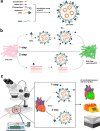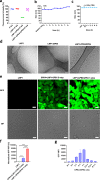Fusogenic Coiled-Coil Peptides Enhance Lipid Nanoparticle-Mediated mRNA Delivery upon Intramyocardial Administration
- PMID: 37982378
- PMCID: PMC10722601
- DOI: 10.1021/acsnano.3c05341
Fusogenic Coiled-Coil Peptides Enhance Lipid Nanoparticle-Mediated mRNA Delivery upon Intramyocardial Administration
Abstract
Heart failure is a serious condition that results from the extensive loss of specialized cardiac muscle cells called cardiomyocytes (CMs), typically caused by myocardial infarction (MI). Messenger RNA (mRNA) therapeutics are emerging as a very promising gene medicine for regenerative cardiac therapy. To date, lipid nanoparticles (LNPs) represent the most clinically advanced mRNA delivery platform. Yet, their delivery efficiency has been limited by their endosomal entrapment after endocytosis. Previously, we demonstrated that a pair of complementary coiled-coil peptides (CPE4/CPK4) triggered efficient fusion between liposomes and cells, bypassing endosomal entrapment and resulting in efficient drug delivery. Here, we modified mRNA-LNPs with the fusogenic coiled-coil peptides and demonstrated efficient mRNA delivery to difficult-to-transfect induced pluripotent stem-cell-derived cardiomyocytes (iPSC-CMs). As proof of in vivo applicability of these fusogenic LNPs, local administration via intramyocardial injection led to significantly enhanced mRNA delivery and concomitant protein expression. This represents the successful application of the fusogenic coiled-coil peptides to improve mRNA-LNPs transfection in the heart and provides the potential for the advanced development of effective regenerative therapies for heart failure.
Keywords: fusogenic coiled-coil; iPSC-CM; intramyocardial delivery; lipid nanoparticles; mRNA delivery.
Conflict of interest statement
The authors declare no competing financial interest.
Figures





References
Publication types
MeSH terms
Substances
LinkOut - more resources
Full Text Sources
Other Literature Sources
Medical
Research Materials

